A population group, geographic area, or facility where residents have diminished access to basic medical care because there are too few primary care physicians relative to the population size of that setting can be designated a primary care health professional shortage area (HPSA) by the Health Resources and Services Administration (HRSA). As of December 31, 2022, HRSA data showed that more than 98.5 million Americans lived in primary care HPSAs. The four-state Southwest region was home to over 13.6 million people who lived in a primary care HPSA. The HRSA estimates that to eliminate this primary care shortage, Southwest HPSAs would need over 2,260 more primary care physicians. As such, the Southwestern U.S. accounted for about 13.3% of the national shortage of primary care physicians. A closer review of 12/31/22 HRSA data reveals the following about the Southwest's primary care shortage:

|
The Southwest's Primary Care Shortage |
|
| State |
(1) HPSAs |
(2) Population |
(3) Shortage |
| AZ |
248 |
3,344,046 |
667 |
| NM |
110 |
1,345,594 |
264 |
| OK |
190 |
1,461,114 |
297 |
| TX |
440 |
7,479,997 |
1,038 |
|
|
|
|
| Region |
988 |
13,630,751 |
2,266 |
|
|
|
|
| U.S. |
8,294 |
98,537,257 |
17,065 |
|
|
|
|
| % of U.S. |
11.9% |
13.8% |
13.3% |
(1) Designated Geographic, Population Group, and Facility HPSAs with a primary care shortage
(2) Population of designated HPSAs
(3) Primary Care practitioners needed to remove HPSA Designation
Source: Designated HPSA Quarterly Summary, 12/31/22 (HRSA)

No comments:
Post a Comment
Let us know what you think about today's commentary!